
|   |

|   |
Music Academy Dance Festival 2018 Memorable Mornings - The best of the lot - Veejai Sai e-mail: vs.veejaysai@gmail.com Images courtesy: Thanthoni, Music Academy January 31, 2018 The Annual Dance Festival of the Music Academy of Madras offered a mixed fare. At a first glance, the schedule didn't enthuse many rasikas with several popular names being repeated. However if one went by the time slots, the first morning slot turned out to be the best of the whole festival. There were at least four debuts (Sudharma Vaidyanathan, Parshwanath Upadhye, Meera Sreenarayanan and Bhavajan Kumar), all by talented youngsters, which were well received. The mid-morning slots of seniors had a few good performances with a greater scope for improvement. Young Sudharma Vaidyanathan's debut was unimpressive at its best. While there were clean lines and geometry, what was lacking was a sense of soushtavam. Sudharma is a talented girl but her stage presence did not come through that morning. Even the performance of Delhi-based Ragini Chandrasekhar was lackluster. Ragini, another intelligent dancer, decided to put up a rather slow show for her experience and age. With a body that was clearly out of practice, her attempt at Swathi Thirunal's Neelambari varnam "Saarasashara Sundara" was feeble. It took her the whole first half of the varnam to warm up and get active on stage. 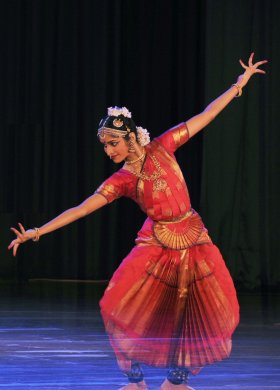 Sudharma Vaidyanathan 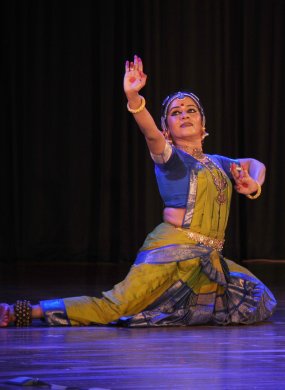 Ragini Chandrasekhar  Christopher Gurusamy  Lakshmi Parthasarathy Athreya The morning panel discussion on 'The Bharatanatyam audience –expanding the appeal' in the Academy's mini-hall ate into a part of Christopher Gurusamy's performance. If there was any way to expand the appeal, it should have to start with better time management. By the time we arrived from the panel discussion, Christopher had begun his varnam. He put up a lackadaisical performance. Only last year when he debuted in the Academy's festival, we saw him as greatly promising. His approach to Arunachala Kavirayar's famous "Yaro ivar yaaro" was static and repetitive. Choreographed by guru Bragha Bessel, the piece expects the dancer to be more invested in it than what is taught, which was clearly lacking in this case. One would expect a better performance from him. The only thing noteworthy about his performance was the excellent orchestra with nattuvangam by Sudarshini, who is turning out to be an excellent nattuvanar in the Kalakshetra tradition, the flute by ubiquitous Sruti Sagar and veena by Ananthanarayanan. While Lakshmi Parthasarathy Athreya began on a good note, it was her selection of items that seemed to obstruct her full potential. R Visweswaran's compositions 'Pravaha Anjali and Ganga Kauthuvam' on Ganga, "Jai Gange" made for an unusual beginning. In "Mohalagiri Kondain," the Tanjore Quartet varnam set to Todi with jatis designed by Karaikudi Krishnamurthy, Lakshmi danced with good energy. The nayika's love for lord Rajagopala of Mannargudi was portrayed in myriad forms through her dance. While a part of the choreography felt cluttered with too many things in it, Lakshmi put up a good show overall. The next debut was Bangalore's superstar Parshwanath Upadhye. Chennai and the December season seem to have woken up late to this much acclaimed young hero. From the very entry of his performance for the Vinayaka Kauthuvam, Parshwanath was a bundle of unstoppable energy. In the main piece "Vanajaksha ninne nammitira," a varnam by T R Subramanyam in ragam Behag and adi talam, his choreography, powerful nritta and much evolved sense of aesthetics in abhinaya were refreshing. Adithya PV's excellent nattuvangam added more gusto to the performance. In the Kanakadasa kriti "Ennendalo Seethe," one witnessed the lament of Rama who is in separation from Sita and the bhakti of Hanuman who comes as a messenger from Lanka after having witnessed the plight of Sita. Parshwanath's abhinaya portraying each of those roles was highly impressive. He ended his performance with a rather complicated thillana called 'Gatibhedapriya Thillana' composed by Dr. M. Balamuralikrishna. The very structure of the thillana could leave a singer breathless as the composer leaves less space between aksharams and maatras. It is rare to find even Carnatic singers try to attempt this, let alone any dancer. Parshwanath's strong sense of taalam saw him present this thillana with great mastery. His orchestra including singer G. Srikanth, mridangist Harsha Samaga, flute by the inimitable Sruti Sagar and veena by A. Shankar Raman added to the performance. The music of the veena also gave a different width and texture to the whole music. What more?! Parshwanath's dance was received with a huge heartfelt standing ovation of several minutes, a first for the morning slot. After this brilliant performance even Meenakshi Srinivasan, who is counted among younger stars, felt pale. She still stood out in the mid-morning as one of the better performers. Her selection of K. Hariprasad's composition "Yelloraiyum" written by V. Vijayaraghavan seemed to lack a basic sthayi bhavam for being explored beyond the usual. Her portrayal of Jayadeva's ashtapadi "Sakhi he" was an excellent attempt. Over the festival, several other dancers presented the same ashtapadi in their respective forms. 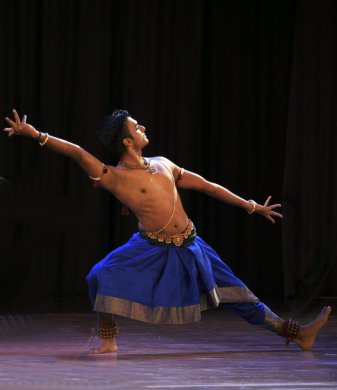 Parshwanath Upadhye 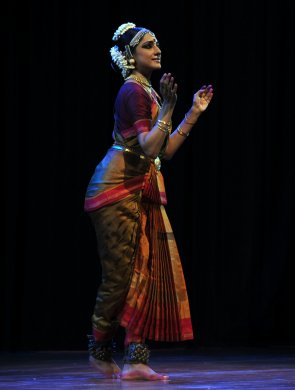 Meenakshi Srinivasan 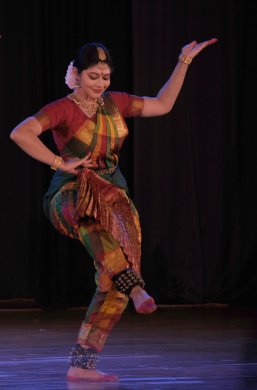 Dakshina Vaidyanathan 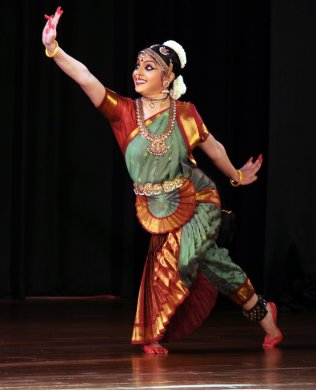 Anwesha Das What followed this was a fairly average affair by Anwesha Das, a student of Urmila Sathyanarayanan. A bit harsh in her approach to both nritta and abhinaya, Anwesha is a good dancer who needs to work much more on her abhinaya. Her choice of selecting Dandayudhapani Pillai's famous varnam "Mohamahinen inda velayil" in Kharaharapriya didn't go beyond the usual mime. With highly rehearsed nritta, her performance was pedantic. Meera Sreenarayanan's debut in the morning slot was highly impressive. Opening with verses from the Shyamala Dandakam, Meera was an epitome of grace from the word go. Her attempt at the famous Nattakurinji varnam "Chalamela Jesevayya," a composition of Moolaveedu Rangaswamy Nattuvanar, was fresh and original. Her performance of ashtapadi "Sakhi he" was noteworthy. Meera trained under Nirmala Nagaraj and RLV Anand before she began under her current guru Indira Kadambi. Bijeesh Krishna's singing, Charudutt V.V's mridangam further enhanced her performance. We have an excellent soloist in the making here. Kudos to her guru Indira Kadambi for giving us an excellent and promising young dancer. What musical compositions suit dance and what don't, should be a subject of discussion in the many panels that float around the music season. Is everything in Carnatic music meant for dance? Are all of Tyagaraja's compositions meant for dance? Certainly not! And this was proved by Aishwarya Balasubramaniam's performance. Training under Guru Anita Guha, Aishwarya is a promising and talented dancer. However, it was her selection of items for the recital that marred her performance. For her main item, Aishwarya chose to perform Tyagaraja's famous Pancharatna kriti "Kanakana Ruchira" in ragam Varali, which comes to questioning the very sthayi bhaavam of this piece. Who was dancing and for whom? Was Tyagaraja dancing for Rama? Was Sita dancing for Rama? Was a third person dancing this kriti describing various incidents in the song? Lord Rama, unlike Shiva and Vishnu, had no other pining nayikas for him. In the rest of the composition, Aishwarya just ended up portraying a literal mime show, word to word. This was just a severely bad choice as a main piece for any dance show. None of the Pancharatna kritis render themselves to dance because they were never written for dance in the first place. This was a wasted opportunity. While Balakrishnan's nattuvangam was excellent, Hariprasad's bad Telugu pronunciation marred the performance.  Meera Sreenarayanan 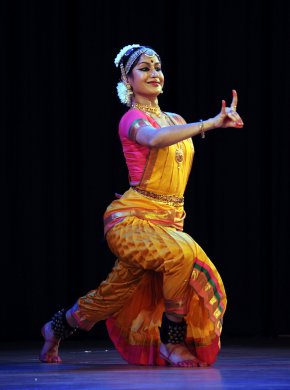 Aishwarya Balasubramaniam 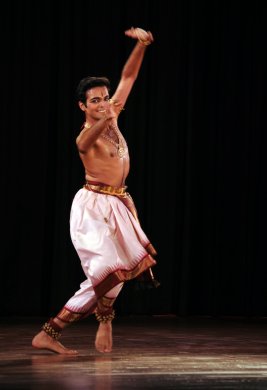 Bhavajan Kumar 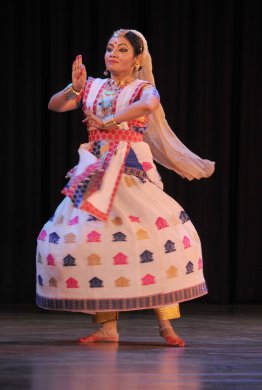 Anwesha Mahanta The last day of the festival debuted Bhavajan Kumar. A known face in the Chennai dance scene, Bhavajan is a Canadian citizen trained under various gurus. One has seen Bhavajan perform in numerous group productions all these years. This year, he debuted as a soloist. The veena-venu music by Ananthanarayanan-Sruti Sagar duo gave a brilliant texture to the opening of his show. From the very first piece Shanmukha Kauthuvam, Bhavajan displayed good artistry in his performance. In his presentation of the famous Shankarabharanam varnam "Manavi Chekonarada" of the Tanjore Quartet, Bhavajan's excellent dance felt stunted by the bad singing of Nandini Anand Sharma. Suffering from a bad throat, Nandini wasn't able to go beyond the basic madhyamam. Much as Bhavajan tried to put up a good show, even his nattuvanar K.P. Rakesh had to slow down because of the singing. Nandini is in demand through the season and by the end of it, loses her voice. This is really unfair for dancers who put in such a lot of hard work and effort into their shows. Bhavajan is a talented dancer and a star in the making. One just needs to wait and watch him grow into an excellent soloist in the years to come. This was followed by an excellent Sattriya solo by Anwesha Mahanta. Watching Anwesha perform, one can say Sattriya has finally found their star ambassador to represent it on a global stage. Mostly based on the poet saint Sankaradeva's writings, Sattriya has gained popularity in the recent past and become a classical dance. What was unique was Anwesha's approach in presenting it. From the beginning Prastavana to the pure dance sequence of Ramdani and Shree Vandana of the Geetar Nach, Anwesha took time to patiently explain all the items she was presenting, well in cognition of the fact that her dance form was hardly seen in Chennai. The best compliment came when those who were never exposed to Sattriya thoroughly enjoyed her performance and gave her a good ovation. Anwesha is the renaissance girl of Sattriya and we are happy she takes the extra effort to make her dance form accessible to us through her presentations. The morning and mid-morning slots at the Academy generally saw more crowds and better performances. Veejay Sai is a writer, editor and culture critic. |